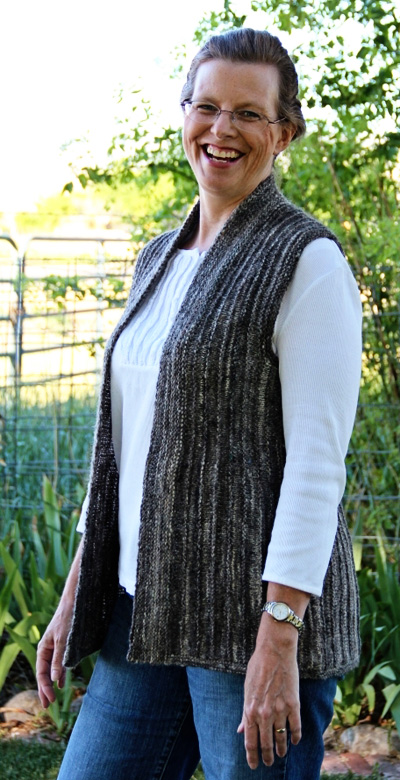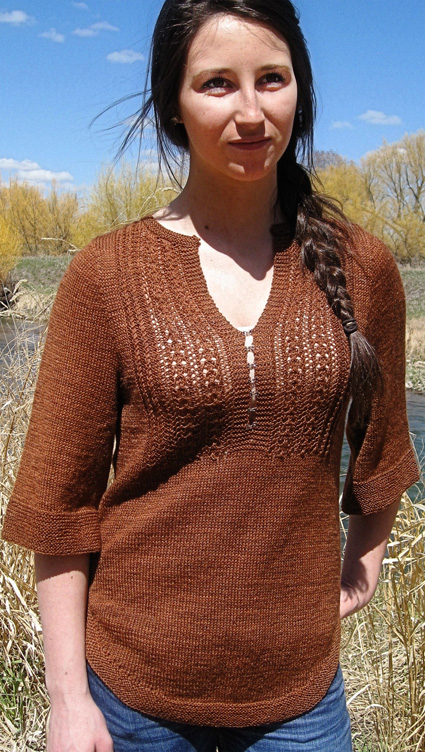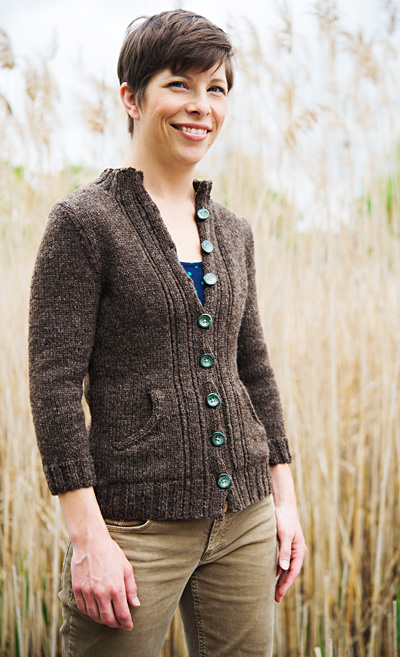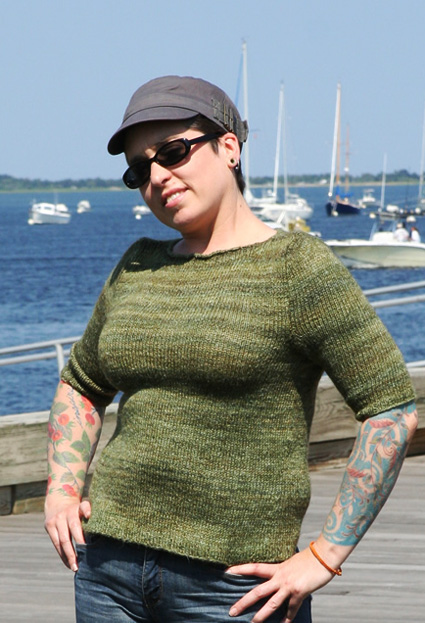Girls with curves had several great pattern options in VK's Fall 2013 issue. It's all about classic designs.
 Usually I work my way through a magazine in page order, but this time I am starting with my favorite, the most classic of all - M. Patmos's grandfather cardigan. Marcia Patmos is a designer I've been following for about a year now because I find her knitwear inspiring. What's inspiring in this design is its simplicity. The slip stitch rib is more interesting than stockinette stitch, plus it not only hugs the body, but creates vertical design lines. A deep v-neck with shawl collar opens up the chest to elongate the body, and the buttons and button band do as well. And the strong fully-fashioned raglan decreases create another very strong flattering design line. What's the red flag here? Watch the length! As always, work to your best length. Also, the pockets add visual bulk, so if you carry weight through the hips, you might want to eliminate them. Me, I would work this exactly as it - if I ever have the time for personal knitting.
Usually I work my way through a magazine in page order, but this time I am starting with my favorite, the most classic of all - M. Patmos's grandfather cardigan. Marcia Patmos is a designer I've been following for about a year now because I find her knitwear inspiring. What's inspiring in this design is its simplicity. The slip stitch rib is more interesting than stockinette stitch, plus it not only hugs the body, but creates vertical design lines. A deep v-neck with shawl collar opens up the chest to elongate the body, and the buttons and button band do as well. And the strong fully-fashioned raglan decreases create another very strong flattering design line. What's the red flag here? Watch the length! As always, work to your best length. Also, the pockets add visual bulk, so if you carry weight through the hips, you might want to eliminate them. Me, I would work this exactly as it - if I ever have the time for personal knitting. 
Another classic design, also in red, is Yoko Hatta's jacket. It's a simple knit - garter stitch and reverse stockinette. As shown, there is no closure to the center front, which creates a strong, slimming vertical line. For the sake of practicality, I would add a closure, maybe toggles? There's a very subtle A-line shape, which is flattering for those who carry their weight through the hips and thighs. But, if that's the case, watch the length. It's not shown here, but in the magazine you can see that it is knit to end at the upper thigh. Good for hiding a big bottom, not so good for hiding thighs. So, adjust length as you need.
A note on yarn choice: we all love merino. But, it does pill badly. On designs as timeless as these, I would suggest giving up a little of merino's softness in favor of a wool that wears a little harder. Since I am not a fiber guru, I would direct you to one like Clara Parkes, whose excellent books and website could lead you to a good yarn choice.
 Another excellent Yoko Hatta design is her A-line, cabled vest/sweater. The cable twists create a strong vertical element, as do the deep v-neck and button band. The hood is an interesting modern twist on a classic design. I really hate that the model's pose hides the sleeve details, but the schematic tells me that they are quite short. To hide my chubby arms, I would lengthen the sleeves to elbow length. I would also add side shaping, which should be easily done in the moss stitch at the sides. But would I really knit this (time issue aside)? Probably not. The deep texture of cables adds a lot of visual weight, and since I carry my weight through the torso, that's not a good match. But, for those knitters who carry their weight lower, this could be a 'go'. Just watch the length, which, again, is not shown here, but is to upper thigh.
Another excellent Yoko Hatta design is her A-line, cabled vest/sweater. The cable twists create a strong vertical element, as do the deep v-neck and button band. The hood is an interesting modern twist on a classic design. I really hate that the model's pose hides the sleeve details, but the schematic tells me that they are quite short. To hide my chubby arms, I would lengthen the sleeves to elbow length. I would also add side shaping, which should be easily done in the moss stitch at the sides. But would I really knit this (time issue aside)? Probably not. The deep texture of cables adds a lot of visual weight, and since I carry my weight through the torso, that's not a good match. But, for those knitters who carry their weight lower, this could be a 'go'. Just watch the length, which, again, is not shown here, but is to upper thigh.
I find Cheryl Murray's color blocked cardigan very interesting. Of course, she's got the color all wrong for the slimming effect that we want, but the lines are good. Love the raglan sleeve and how the raglan lines are echoed by the vertical color blocking. And, of course I love that it's a cardigan with those lovely shell buttons. But, let's chat about the color. To visually slim the torso, we would want to have the lightest color in the center, and then fade to darker at the sides. And those of us with fat upper arms really don't want them in a bright contrast color. But, reverse the order, and you've got something that works for us. In fact, this could be a pattern to get me motivated to drag my knitting machine out from under the bed. Why bother to hand knit stockinette stitch when you've got a much quicker alternative? I haven't mentioned the split hem. This is a very trendy detail, so go ahead and work it up with the split and enjoy being at the height of fashion, but save some yarn to sew them together next year for a longer-lasting design.

The last pattern I want to present is the trendiest, but it's got interesting, and flattering, design lines. Pat Olski's cabled color block vest has the 'mullet' hemline that a big fad. (Why 'mullet'? Like the 80's haircut, shorter in the front, longer in the back.) In this design, the mullet hem not only cuts right across the bottom, it seems to cup and hold it. I'll leave it to you to decide if your rear can stand up against that degree of attention. If not straighten out the hem (making it a much simpler knit), you've got a much more classic design. A beautiful deep v-neck with strong contrasting bands make a good vertical line. The contrasting color and cable patterning draw attention to the bust, so if you are generously endowed, consider working a more subtle contrast color. A dark, medium and light tone of one color would be lovely.
Those are my favorites for VK. Knitter's also arrived in the mail this past weekend, so I will get to that review in the next day or so. The latest issue of the Twist Collective is also not available on-line, and since that is always good, I'm eager to review that, too. As soon as we're past the rush of fall pattern releases, we'll chat on other topics, like fit, pattern adaptions, book reviews, etc. Lots to discuss.











